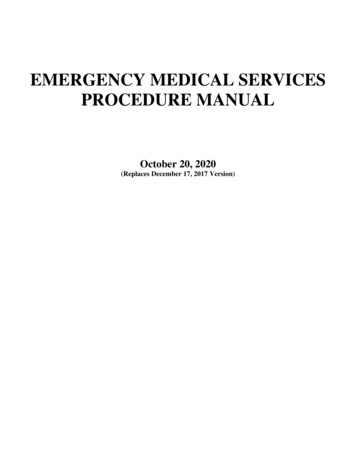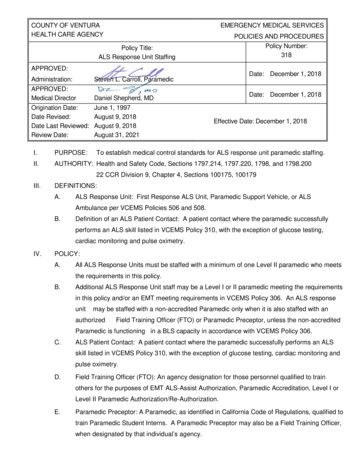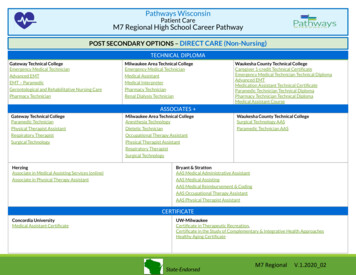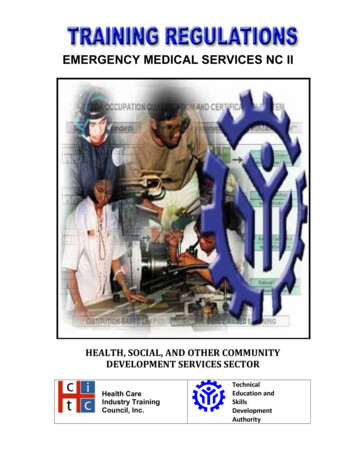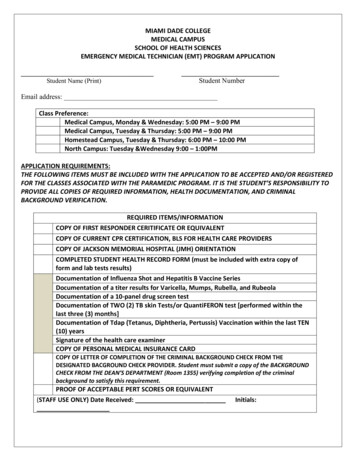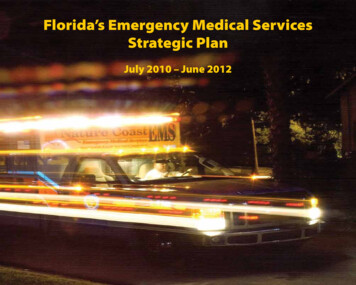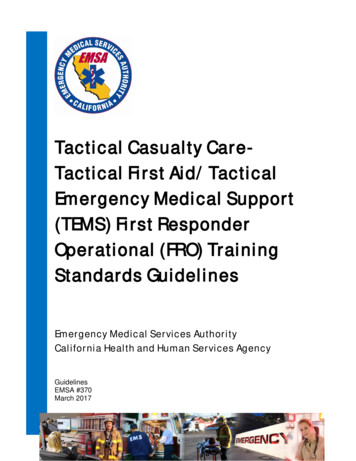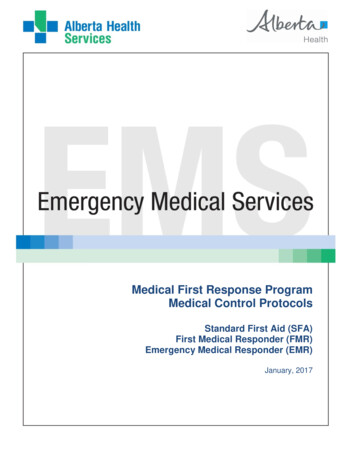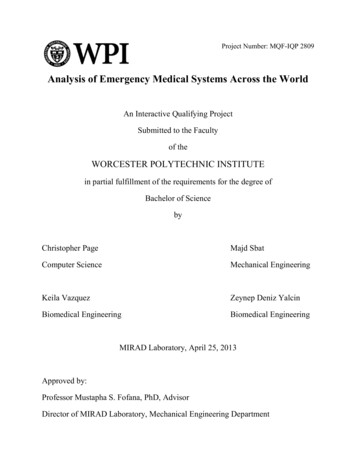
Transcription
Project Number: MQF-IQP 2809Analysis of Emergency Medical Systems Across the WorldAn Interactive Qualifying ProjectSubmitted to the Facultyof theWORCESTER POLYTECHNIC INSTITUTEin partial fulfillment of the requirements for the degree ofBachelor of SciencebyChristopher PageMajd SbatComputer ScienceMechanical EngineeringKeila VazquezZeynep Deniz YalcinBiomedical EngineeringBiomedical EngineeringMIRAD Laboratory, April 25, 2013Approved by:Professor Mustapha S. Fofana, PhD, AdvisorDirector of MIRAD Laboratory, Mechanical Engineering Department
AbstractThis Interactive Qualifying Project (IQP), prepared for MIRAD Laboratory, provides abasic understanding of the role of emergency medical services (EMS) in selected countriesaround the world. An overview of the Anglo-American and Franco-Germany EMS systems andtheir structure, functions and governing standards of operations are presented. A substantialnumber of countries around the world are using these systems as a framework to providequality care in pre-hospital or emergency medicine. The Franco-German system is a PhysicianEMS-based model that enables a Doctor and EMS to evaluate and treat a patient on the sceneof a medical emergency. The patient can be taken to a hospital or clinic if further evaluation isrequired. The Anglo-American model, on the other hand, consists of ambulances staffed withEmergency Medical Technicians (EMTs) and Paramedics trained in Basic, Intermediate andAdvanced life support. They provide pre-hospital emergency care, including stabilization,intervention and the transport of the patient to a hospital or clinic for further evaluation byemergency Doctors or Physicians. The IQP presents analysis of the Franco-German and AngloAmerican models. Selected countries with varying economic, political, and geographicbackgrounds are studied. These countries include the United States, the Sultanate of Oman,Germany, Portugal, the People’s Republic China, and South Africa. This IQP presents how eachof these countries have utilized modified versions of the two models to fit their emergencymedicine practices and capabilities. The derived results provide an opportunity for the IQPteam to appreciate the social impact of pre-hospital services and the ethical challenges that areinvolved in delivering continuous quality of patient care in a sustained manner.i
Table of ContentsAbstractiTable of ContentsiiList of FiguresvList of TablesviiAcknowledgmentviiiCHAPTER 1. EMERGENCY MEDICAL SERVICES AND THEIR MODELS11. Introduction1CHAPTER 2. EMS SYSTEMS AROUND THE WORLD32. Introduction32.1 Africa42.1.1 South Africa52.2 Asia82.2.1 Hong Kong82.2.2 People’s Republic of China112.2.3 Taiwan142.3 Europe172.3.1 Germany172.3.2 Greece222.3.3 Lithuania262.3.4 Portugal292.3.5 United Kingdom312.4 Middle East352.4.1 Sultanate of Oman352.5 North America372.5.1 Canada382.5.2 United States of America42CHAPTER 3. EMS IN SELECTED CITIES OF THE UNITED STATES463. Introduction46ii
3.1 Boston EMS463.1.1 2011 Statistics for Boston EMS483.1.2 Clinical Innovation523.1.3 Fleet Services533.1.4 Training and Education543.1.5 Emergency Preparedness553.1.6 Dispatch Operations573.1.7 Special Operations593.2 New York Fire Department613.2.1 New York City Fire Department Sustainability Initiatives623.2.2 Training633.2.3 Major Incident Responses643.2.4 Improvements663.3 Seattle EMS673.3.1 System Overview683.3.2 EMS Division Programs Overview683.3.2.1 Training703.3.2.2 EMS Divisions713.3.3 Medical Quality Improvement713.3.4 EMS Awards743.3.5 Communities of Care743.3.6 Injury Prevention753.3.7 EMS Child Passenger Safety Program753.3.8 Distracted Driving Project763.3.9 EMS Administration763.3.10 King County Medic One Program763.3.10.1 King County Medic One Medical Direction773.3.10.2 Training773.3.10.3 Operations, Preparedness and Safety79iii
3.3.10.4 Effectiveness793.3.10.5 Administration793.3.11 EMS Funding and 2012 Financial Plan3.3.11.1 Expenditures79803.3.11.2 EMS Grants, Donation, and Entrepreneurial Projects related to PublicHealth83CHAPTER 4. CONCLUSION: A COMPARISON OF EMS MODELS IN SELECTED COUNTRIES844. Introduction844.1 Hospital Bed Density and Physician Density854.2 Total Healthcare Spending in G7 Countries874.3 A Comparison of Selected Countries88REFERENCES91iv
List of FiguresFigure 1: A map showing the location of South AfricaFigure 2: An ambulance belonging to ER24 EMS at a rugby matchFigure 3: A map with an arrow pointing to Hong KongFigure 4: An ambulance heading towards Kwong Wa Hospital in Hong KongFigure 5: A map with the PRC highlighted in green (sans claimed territories)Figure 6: Dispatch Process Flowchart for People's Republic of ChinaFigure 7: An ambulance belonging to the Shanghai Pudong Medical Emergency CenterFigure 8: A map with Taiwan highlighted in greenFigure 9: An ambulance in TaiwanFigure 10: A map with Germany highlighted in greenFigure 11: Dispatch Process Flowchart for GermanyFigure 12: An ambulance at a German soccer fieldFigure 13: A map showing Greece’s locationFigure 14: Dispatch Process Flowchart for GreeceFigure 15: A map of the location of LithuaniaFigure 16: A map with Portugal highlightedFigure 17: Dispatch Process Flowchart for PortugalFigure 18: A map showing the location of the United KingdomFigure 19: Dispatch Process Flowchart for United KingdomFigure 20: An ambulance belonging to South Western Ambulance ServiceFigure 21: A map showing the Sultanate of OmanFigure 22: A map with Canada highlighted in greenFigure 23: The location of the United States of AmericaFigure 24: An ambulance used by Boston EMSFigure 25: Number of Transport and Clinical IncidentsFigure 26: Ratio of Transports to Clinical IncidentsFigure 27: 2011 Transports by AgeFigure 28: 2011 Call Response TimesFigure 29: The entrance to Boston EMS’ Dispatch OperationsFigure 30: Adopted Expense Budget Funding (2005-2008)Figure 31: Response Times (2005-2009)Figure 32: A Map of King County, WAFigure 33: The Five Major Tiers in the Medic One/EMS SystemFigure 34: Different levels of training in KCM1Figure 35: 2011 Actual Expenditures for King County EMSFigure 36: 2012 Budget for King County 84850585962676869788182
Figure 37: Regional Support Services & 2011 Actual Expenditure for King CountyFigure 38: Hospital Bed Density vs. Physician DensityFigure 39: Total Healthcare Spending in G7 CountriesFigure 40: Percentage of AAMS Countries with Public Healthcarevi83868790
List of TablesTable 1: Boston EMS Service Area InformationTable 2: Incidents by TypeTable 3: 2011 Incidents by NeighborhoodTable 4: 2011 Median Response TimesTable 5: Comparison of Training ProgramsTable 6: A Comparison of EMS Systems across Selected Countries and CitiesTable 7: Strengths and Weaknesses of Selected Countriesvii47494951558889
AcknowledgmentWe would like to thank Stephen Hayes and his colleagues at UMass Memorial MedicalEmergency Medical Services. Their effort provides us the opportunity to learn about the dailychallenges of balancing the quality of care, ethics and responsibilities. They provide us anoverview of EMS services, training and education of Basic Life Support (BLS), Intermediate LifeSupport (ILS) and Advanced Life Support (ALS) or paramedics, and their respective roles andduties in ambulatory care. We are also very thankful to Neil Blackington of Boston EMS and itsambulance mechanics for all their insightful contribution in helping us to expand ourunderstanding of pre-hospital services and their social impact input. Finally we thank ProfessorMustapha S. Fofana for his role as our project advisor and mentor in this project.viii
CHAPTER 1. EMERGENCY MEDICAL SERVICES AND THEIR MODELS1. IntroductionThere is an increasing demand for Emergency Medical Services (EMS) in the United States andaround the world. To respond to this growing demand, the EMS communities require adaptableand sustainable model systems that encompass unified standards of practice, training andresults with minimum risk. Millions of patients with simple or complicated conditions or injuriesseek pre-hospital care around the world. EMTs with knowledge of Basic Life Support (BLS),Intermediate Life Support (ILS) or Advanced Life Support (ALS) or First Responders, as they aregenerally called in the United States, provide rapid assessments and treatment of the sick andinjured prior to transporting them to a hospital or clinic for further evaluation. Considerableknowledge, skill, and judgment are required to provide quality ambulatory emergency medicalservices. High quality emergency medical services and first responders are important part ofany health care system. Many studies of pre-hospital services place greater emphasis on humanfactors, efficiency and continuous refinement of standards of practice.Worldwide Emergency Medical Services are divided into two main models: (1) theGerman-Franco Model, in which an ambulance is staffed by physicians, and (2) the AngloAmerican Model, where ambulances are staffed with EMTs trained in BLS, ILS or ALS. In bothmodels, effort is made to use modern techniques, tools and technologies to reduce medicaluncertainties so as to attain the highest possible quality of patient-centric pre-hospital care.Many countries around the world are using these ideas to support and improve their pre-1
hospital services and emergency medicine. Oftentimes, in most countries, compromises aremade in order to provide efficient pre-hospital services while staying within budgets and thecapacity of existing infrastructure. Individual countries also have different environmentalperformance and public health issues to contend with. The lack of trained pre-hospitalproviders, modern equipment and ambulance vehicles for example, also account for thechallenges and short comings to provide quality emergency medical services. For manycountries, the Anglo-American and Franco-German models are the guiding framework for theiremergency medical services and continuing advancement in providing quality emergencymedicine. Several significant factors, such as the improvement of EMS access, telemedicine andgreater availability of pre-hospital services in rural areas, have resulted from the use of the EMSmodels.The objective of this project is to provide an overview of EMS systems across differentcountries in different parts of the world. This IQP focuses on countries from the continents ofAfrica, Asia, Europe, the Middle East and North America. In North America, this project studiesthe EMS systems in Canada and the United States. This project considers the EMS systems ofEuropean countries, namely Portugal, the United Kingdom, Germany, Greece, and Lithuania. InAfrica, country of South Africa was considered. In the Middle East, the EMS system of theSultanate of Oman was evaluated. This project studies the EMS systems of the People’sRepublic of China, Hong Kong and Taiwan in Asia. The selection of these countries is basedupon their distinctive differences among them in terms of their economic, political, andgeographic backgrounds.2
We describe how the Franco-German and Anglo-America models have been used bythese countries to modernize their emergency medical systems. An overview of the socialimpact of emergency medicine and balance of ethics between standards of care and the abilityto stay within budget is presented. The four chapters of this project provide an opportunity forthe readers to understand the development and effectiveness of Emergency Medical Services inthe selected countries. In Chapter 1, the report conveys the general purpose of the project, itsmotivation and objectives. Chapter 2 presents an overview of the state of emergency medicinein the selected countries. Evaluation was completed on how these countries continue toimprove their emergency medical systems using the two models. Chapter 3 presents acomparison among the EMS services from selected cities in the United States of America. InChapter 3, an analysis of the Franco-German and Anglo-America EMS Models in terms of theirapplications in in the selected countries is presented. The last chapter discusses the conclusionof the project and recommendations for future project work in pre-hospital care.CHAPTER 2. EMS SYSTEMS AROUND THE WORLD2. IntroductionThere is a growing realization worldwide that nations will face major challenges to protect theircitizens from an increasing number of health threats initiated by man-made or naturalemergencies and disasters. The lessons learned from hurricane Katrina, the Fukushima Daiichinuclear disaster, hurricane Sandy and the earthquake in Haiti are still fresh in our minds. Whennational and international doctors and emergency personnel arrive at medical emergencies ordisaster scenes, they are often confronted with changing demands and safety threats created3
by environmental changes, uncertain emergency scenarios and medical challenges. EMSproviders are expected to render effective life-saving evaluation, intervention, stabilization andtreatment that are consistent with existing standards and codes. Emergency personnel must beproperly trained and equipped with suitable equipment, tools and communication systems toensure that the highest quality of care, safety and reliability are attained before, during andafter a medical emergency event (see the references [8-17]). Many countries have embracedmodified versions of the Franco-German and Anglo-America EMS models to improve their prehospital care (see the references [6, 30, 42, 43, 45-54, 56). There are continued innovations toimprove the models so as to address the many challenges facing pre-hospital providers (see thereferences [19-27]).The rating cards of emergency medicine by the American College ofEmergency Physicians and public scrutiny and attention to greater safety and reliability in prehospital or emergency medicine care also place more emphasis on identifying measures ofquality, risks and performance [19-20, 22-27].2.1 Africa
Table 5: Comparison of Training Programs 55 Table 6: A Comparison of EMS Systems across Selected Countries and Cities 88 Table 7: Strengths and Weaknesses of Selected Countries 89. viii Acknowledgment We would like to thank Stephen Hayes and his colleagues at UMass Memorial Medical Emergency Medical Services. Their effort provides us the opportunity to learn about the daily

